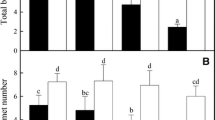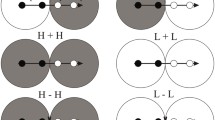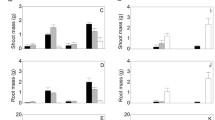Abstract
The capacity of succulent plants to create new invasive focus starting from disconnected plant fragments involves severe difficulties in the management of invaded areas. In the case of the succulent stoloniferous Carpobrotus edulis, clonality further difficults land restoration since management practices usually fragment and outspread vegetative propagules. In order to contribute to a better management of this highly invasive species, we explored fragment viability during the first month after disconnection. We hypothesized that period after separation from maternal clumps and propagule size, both influence the capacity of C. edulis to establish and develop new vegetative structures. With this objective, we separate apical fragments with two different sizes that were sown under greenhouse conditions after a sequence of storing time. We further examined morphological and physiological attributes as survival, length growth and biomass, FW/DW ratio, relative water content and leaf hydration, osmolarity and fluorescence. Biochemical parameters were also included through the measurement of phenol and tannin content together with photosynthetic pigments (chlorophyll a,b and carotenoids) and derived ratios. After 2 months, apical propagules did not show signs of morphological, physiological or biochemical deterioration with increasing storing periods. Propagules showed improved or at least similar performance after storing for longer periods, with slight or no differences between different sized propagules in morphological or physiological values as indicated by the absence of enhanced leaf water status, the maintenance of photosynthetic efficiency (high Fv/Fm values) and the stability in photosynthetic pigments content. Our results indicate that the growth of C. edulis propagules is not significantly constrained during the first month after disconnection, no matter the size of apical fragment considered. As a final remark, we consider that our results are important to ameliorate and efficiently monitor and manage invaded areas where C. edulis had been recently eliminated.





Similar content being viewed by others
References
Adams WW III, Demmig-Adams B (2004) Chlorophyll fluorescence as a tool to monitor plant response to the environment. In: Papageorgiou GC, Govindjee (eds) Chlorophyll a fluorescence. A signature of photosynthesis. Springer, Netherlands, pp 583–604
Barbehenn RV, Constabel CP (2011) Tannins in plant–herbivore interactions. Phytochemistry 72:1551–1565
Barbier EB, Hacker SD, Kennedy C, Koch EW, Stier AC, Silliman BR (2011) The value of estuarine and coastal ecosystem services. Ecol Monogr 81:169–193
Blokhina O, Virolainen E, Fagerstedt KV (2003) Antioxidants, oxidative damage and oxygen deprivation stress: a review. Ann Bot 91:179–194
Brunel S, Schrader G, Brundu G, Fried G (2010) Emerging invasive alien plants for the Mediterranean Basin. EPPO Bull 40:219–238
Catchpole WR, Wheeler CJ (1992) Estimating plant biomass: a review of techniques. Aust Ecol 17:121–131
Cheynier V, Comte G, Davies KM, Lattanzio V, Martens S (2013) Plant phenolics: recent advances on their biosynthesis, genetics, and ecophysiology. Plant Physiol Biochem 72:1–20
D’Antonio CM, Mahall BE (1991) Root profiles and competition between the invasive, exotic perennial, Carpobrotus edulis, and two native shrub species in California coastal scrub. Am J Bot 78:885–894
Dick JM, Leakey RRB (2006) Differentiation of the dynamic variables affecting rooting ability in juvenile and mature cuttings of Cherry (Prunus avium). J Hortic Sci Biotechnol 81:296–302
Dong BC, Zhang MX, Alpert P, Lei GC, Yu FH (2010) Effects of orientation on survival and growth of small fragments of the invasive, clonal plant Alternanthera philoxeroides. PLoS ONE 5:e13631
Dong BC, Liu RH, Zhang Q, Li HL, Zhang MX, Lei GC, Yu FH (2011) Burial depth and stolon internode length independently affect survival of small clonal fragments. PLoS ONE 6:e23942
European Environment Agency (2016) European Nature Information System—EUNIS. http://eunis.eea.europa.eu/habitats.jsp
FAO (2000) Quantification of tannins in tree foliage. Laboratory manual. Joint FAO/IAEA division of nuclear tecnhiques in food and agriculture. FAO/IAEA working document, IAEA, Vienna
García-Plazaola JI, Becerril JM (2001) Seasonal changes in photosynthetic pigments and antioxidants in beech (Fagus sylvatica) in a Mediterranean climate: implications for tree decline diagnosis. Funct Plant Biol 28:225–232
Gorelick R (2015) Why vegetative propagation of leaf cuttings is possible in succulent and semi-succulent plants. Haseltonia 20:51–57
Grace MH, Yousef GG, Gustafson SJ, Truong VD, Yencho GC, Lila MA (2014) Phytochemical changes in phenolics, anthocyanins, ascorbic acid, and carotenoids associated with sweetpotato storage and impacts on bioactive properties. Food Chem 145:717–724
Guerra-García A, Golubov J, Mandujano MC (2015) Invasion of Kalanchoe by clonal spread. Biol Invasions 17:1615–1622
Ings J, Mur LA, Robson PR, Bosch M (2013) Physiological and growth responses to water deficit in the bioenergy crop Miscanthus x giganteus. Front Plant Sci 4:468
Kartzinel TR, Hamrick JL, Wang C, Bowsher AW, Quigley BG (2015) Heterogeneity of clonal patterns among patches of kudzu, Pueraria montana var. lobata, an invasive plant. Ann Bot 116:739–750
Kettenring KM, Mock KE, Zaman B, McKee M (2016) Life on the edge: reproductive mode and rate of invasive Phragmites australis patch expansion. Biol Invasions 18:2475–2495
Klimešová J, Klimeš L (2007) Bud banks and their role in vegetative regeneration—a literature review and proposal for simple classification and assessment. Perspect Plant Ecol 8:115–129
Konlechner TM (2008) The management challenge posed by marine dispersal of terrestrial plants in coastal dune systems. N Z Geogr 64:154–156
Konlechner TM, Orlovich DA, Hilton MJ (2016) Restrictions in the sprouting ability of an invasive coastal plant, Ammophila arenaria, from fragmented rhizomes. Plant Ecol 217:521–532
Lechuga-Lago Y, Sixto-Ruiz M, Roiloa SR, González L (2016) Clonal integration facilitates the colonization of drought environments by plant invaders. AoB Plants plw023. doi:10.1093/aobpla/plw023
Lichtenthaler HK, Wellburn AR (1983) Determinations of total carotenoids and chlorophylls a and b of leaf extracts in different solvents. Biochem Soc Trans 11:591–592
Liew J, Andersson L, Boström U, Forkman J, Hakman I, Magnuski E (2013) Regeneration capacity from buds on roots and rhizomes in five herbaceous perennials as affected by time of fragmentation. Plant Ecol 214:1199–1209
Liu J, Dong M, Miao SL, Li ZY, Song MH, Wang RQ (2006) Invasive alien plants in China: role of clonality and geographical origin. Biol Invasions 8:1461–1470
Maun MA (2009) The biology of coastal sand dunes. Oxford University Press, Oxford
Morales M, Onate M, García MB, Munné-Bosch S (2013) Photo-oxidative stress markers reveal absence of physiological deterioration with ageing in Borderea pyrenaica, an extraordinarily long-lived herb. J Ecol 101:555–565
Novoa A, González L, Moravcová L, Pyšek P (2012) Effects of soil characteristics, allelopathy and frugivory on establishment of the invasive plant Carpobrotus edulis and a co-occuring native, Malcolmia littorea. PLoS One 7:e53166
Novoa A, Rodríguez R, Richardson D, González L (2014) Soil quality: a key factor in understanding plant invasion? The case of Carpobrotus edulis (L.) NE Br. Biol Invasions 16:429–443
Pearse IS, Hipp AL (2012) Global patterns of leaf defenses in oak species. Evolution 66:2272–2286
Rao KM, Raghavendra AS, Reddy KJ (2006) Physiology and molecular biology of stress tolerance in plants. Springer Science & Business Media, Berlin
Roiloa SR, Retuerto R (2016) Effects of fragmentation and seawater submergence on photochemical efficiency and growth in the clonal invader Carpobrotus edulis. Flora Morphol Distrib Funct Ecol Plants 225:45–51
Roiloa SR, Rodríguez-Echeverría S, de la Pena E, Freitas H (2010) Physiological integration increases the survival and growth of the clonal invader Carpobrotus edulis. Biol Invasions 12:1815–1823
Roiloa SR, Rodríguez-Echeverría S, Freitas H, Retuerto R (2013) Developmentally-programmed division of labour in the clonal invader Carpobrotus edulis. Biol Invasions 15:1895–1905
Roiloa SR, Campoy JG, Retuerto R, Alonso Á, Castro-Díez P (2015) Understanding the role of clonal integration in biological invasions. Ecosistemas 24:76–83
Roiloa SR, Retuerto R, Campoy JG, Novoa A, Barreiro R (2016) Division of labor brings greater benefits to clones of Carpobrotus edulis in the non-native range: evidence for rapid adaptive evolution. Front Plant Sci 7:349
Ruffino L, Krebs E, Passetti A, Aboucaya A, Affre L, Fourcy D et al (2015) Eradications as scientific experiments: progress in simultaneous eradications of two major invasive taxa from a Mediterranean island. Pest Manag Sci 71:189–198
Wilson PJ (1994) Contributions of the leaves and axillary shoots to rooting in Eucalyptus grandis stem cuttings. J Hortic Sci 69:999–1007
Xavier A, Santos GD, Oliveira MD (2003) Enraizamento de miniestaca caulinar e foliar na propagação vegetativa de cedro-rosa (Cedrela fissilis Vell.) (in Portuguese). Rev Árvore 27:351–356
Yu FH, Roiloa SR, Alpert P (2016) Editorial: global change, clonal growth, and biological invasions by plants. Front Plant Sci 7:1467
Acknowledgements
This research was carried out within the frame of the project “Retos en la gestión de la planta invasora Carpobrotus edulis. Variabilidad fenotípica y cambios en la relación suelo-planta durante el proceso de invasión” (in Spanish), reference CGL2013-48885-C2-1-R, founded by the Ministry of Economy and Competence (Spanish Government). We also thank two anonymous reviewers for their helpful comments that substantially improve the final version of the manuscript.
Author information
Authors and Affiliations
Corresponding author
Rights and permissions
About this article
Cite this article
Souza-Alonso, P., González, L. Don’t leave me behind: viability of vegetative propagules of the clonal invasive Carpobrotus edulis and implications for plant management. Biol Invasions 19, 2171–2183 (2017). https://doi.org/10.1007/s10530-017-1429-x
Received:
Accepted:
Published:
Issue Date:
DOI: https://doi.org/10.1007/s10530-017-1429-x




